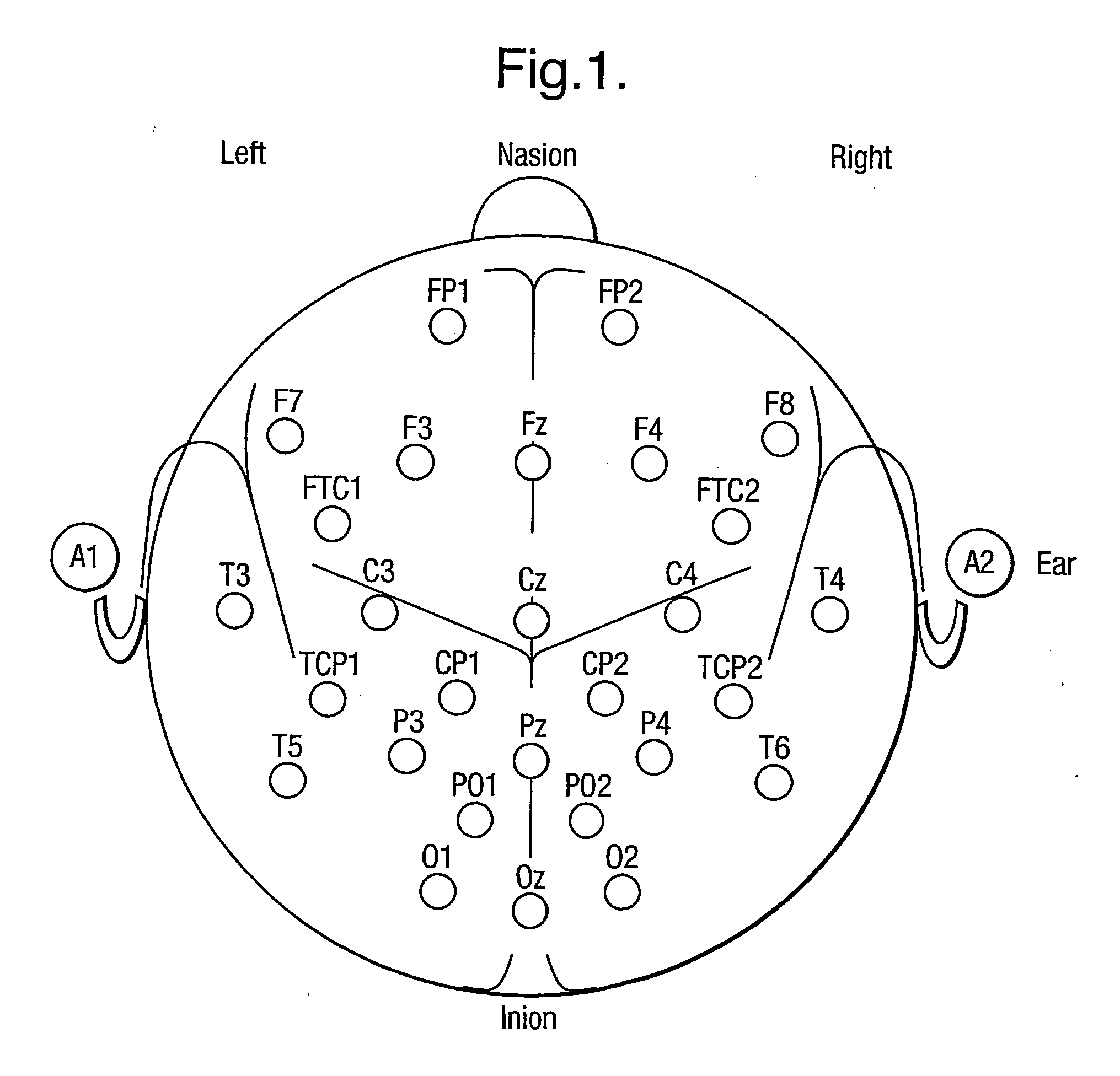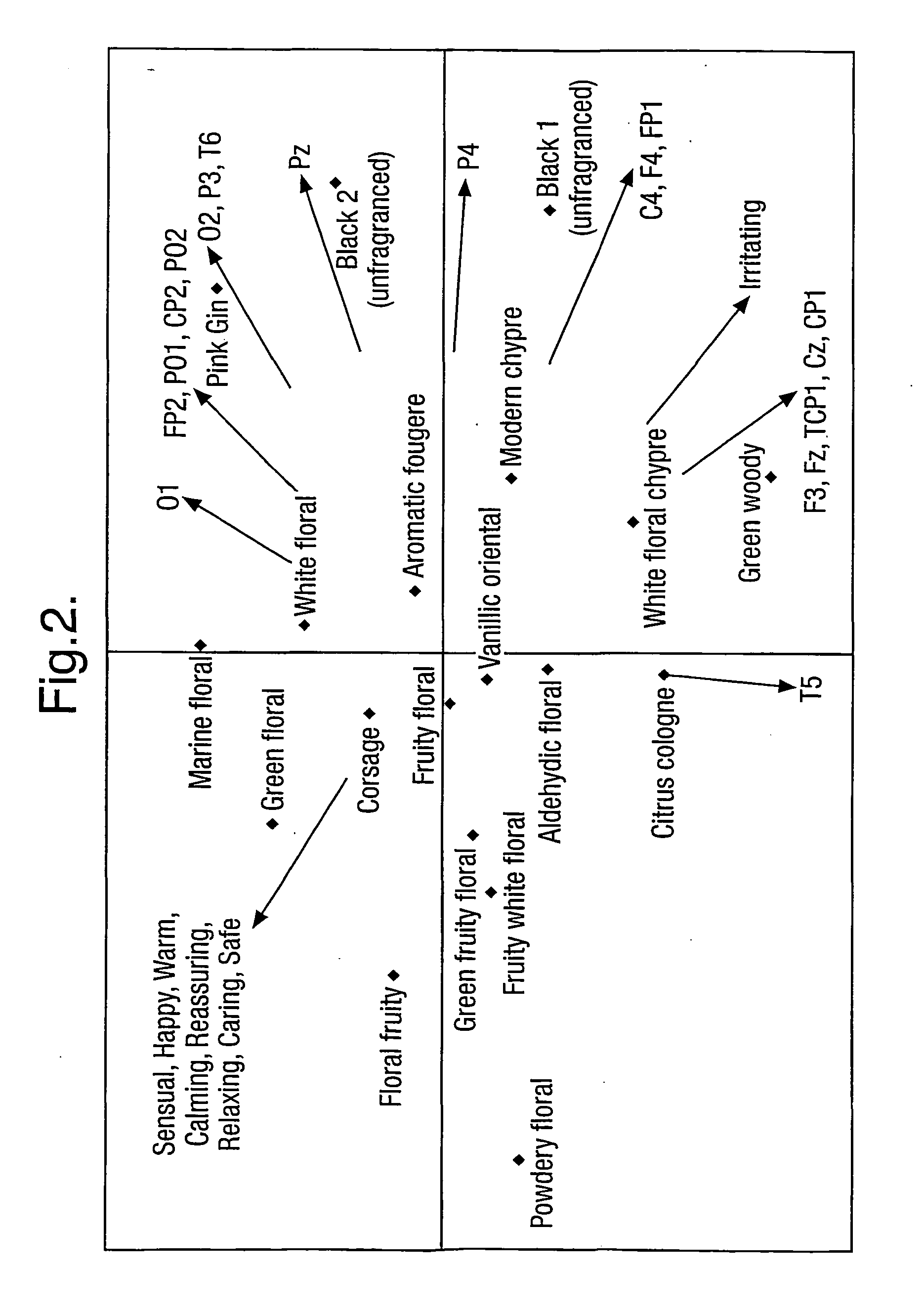Perfume compositions
a technology of compositions and perfumes, applied in the field of perfume compositions, can solve the problems of difficult for formulators to reliably use literature information to make effective perfumes, mood state change, and inability to optimise materials for their acceptability, etc., and achieves sufficient pleasantness/acceptability, good hedonic properties, and high activation
- Summary
- Abstract
- Description
- Claims
- Application Information
AI Technical Summary
Benefits of technology
Problems solved by technology
Method used
Image
Examples
examples 7-8
[0058] Comparative Examples of Relaxing (R7) and Non-Relaxing (NR1) Perfume Compositions.
4 w / w % INGREDIENT Class R7 NR1 ACETYL CEDRENE NR 0.00 14.58 ALDEHYDE MNA NR 0.00 0.05 ALLYL AMYL GLYCOLATE (Q) NR 0.00 0.36 AMBERLYN SUPER PM (Q) NR 0.00 0.27 BANGALOL (Q) R 1.46 0.00 BENZYL ACETATE (Q) N 5.48 6.84 CARVONE LAEVO (Q) N 0.15 0.18 DIHYDRO MYRCENOL (Q) N 4.38 5.47 ETHYLENE BRASSYLATE R 1.68 0.00 FLOROSA R 13.14 0.00 HYDROXYCITRONELLAL N 7.30 9.11 JASMIN N 0.95 1.18 JASMOPYRANE FORTE (Q) N 3.94 4.92 LIGUSTRAL (Q) NR 0.00 0.55 LINALOL N 7.56 9.43 LINALYL ACETATE N 5.84 7.29 LYRAL NR 0.00 6.84 MDJ N 19.43 24.27 METHYL IONONE ALPHA ISO R 18.25 0.00 ORANGE OIL NR 0.00 2.28 PHENYL ETHYL ALCOHOL N 5.11 6.38 SILVANONE (Q) R 2.92 0.00 TERPINEOL ALPHA R 2.19 0.00 UNDECALACTONE GAMMA R 0.22 0.00 total: 100% 100% Sum R 39.86 0.00 Sum NR 0.00 24.93 Sum N 60.14 75.07 Sum M -- -- Ratio -- -- R / NR Ratio -- -- R / (M + NR)
example 9
[0059] Relaxing Perfume Composition (R8) Incorporating Significant Proportion of Class M Materials
5 w / w % Ingredient Class R8 ACETYL CEDRENE NR 1 ANTHER (Q) M 0.4 BANGALOL (Q) R 0.4 BEAUVERTATE (Q) M 0.3 BENZYL ACETATE N 2 BOURGEONAL(Q) NR 0.6 CEDAR LEAF OIL (10% in DPG) NR 0.6 ETHYL LINALOL R 9 ETHYL LINALYL ACETATE M 2 ETHYL SAFRANATE (Q) (10% in DPG) NR 0.2 FLOROSA (Q) R 18 GERANYL NITRILE (10% in DPG) NR 0.9 HEXYL CINNAMIC ALDEHYDE M 9 INDOLAL (10%) DPG M 0.1 JASMOPYRANE FORTE (Q) N 1 MEFROSOL (Q) NR 4.5 MENTHANYL ACETATE M 3 METHYL IONONE ALPHA ISO R 4 METHYL ISO EUGENOL M 0.3 MOSS OAKMOSS SYNTHETIC (10% in DPG) NR 0.2 OZONAL BASE (Q) M 0.3 PATCHOULI OIL ACID WASHED N 1 PHENYL ETHYL ALCOHOL N 4 PARTA-TERT.BUTYL CYCLOHEXYL M 3 ACETATE SILVANONE (Q) R 4 TERPINEOL ALPHA R 3 TETRAHYDROGERANIOL NR 1 TRASEOLIDE (Q) R 25 ULTRAVANIL (Q) (1% in DPG) R 0.7 YLANG-YLANG N 0.5 total 100 class analysis (excluding solvent) sum R 65.22 sum NR 7.42 sum N 18.64 sum M 18.72 Ratio: R / NR 8.79 Ratio...
example 10
[0060] Further Embodiments of Perfume Compositions (R9 to R12) in Accordance with the Invention, with Good Hedonic Properties.
6 w / w % INGREDIENT Class R9 R10 R11 R12 ACETYL CEDRENE NR 4 5 3.5 0 ANETHOLE R 0.1 0 0 0 ANISIC ALDEHYDE M 0 0 0.5 1 ANTHER M 0.8 0 0 0 BANGALOL (Q) R 0.5 0 0.5 1.4 BENZYL ACETATE N 4 0 0 1 BOURGEONAL (Q) NR 0.3 0.5 0.2 0.1 CINNAMIC ALCOHOL N 0 0 0 0.8 CIS 3 HEXENOL R 0.2 0 0 0 CIS 3 HEXENYL ACETATE M 0.2 0 0 0 CITRONELLOL NR 0 0 2 1.5 DECALACTONE GAMMA N 0 0.3 0 0 DEWFRUIT BASE (Q) M 0.1 0 0 0 DIHYDROEUGENOL N 0 0.3 0 0.1 DIPROPYLENE GLYCOL Solv 6.6 25.6 10 9.6 ETHYL LINALOL R 10 4 1.5 0 ETHYL LINALYL ACETATE M 5 0 3.5 1 ETHYL SAFRANATE (10% in DPG) NR / Solv 0 0.2 0 0.6 ETHYL VANILLIN M 0 0 0 0.5 FLOROSA (Q) R 15 15.2 3 10 GERANYL NITRILE (10% in DPG) NR / Solv 2 0.2 0 0 HELIOTROPIN NR 0 0 0 0.9 HEXYL CINNAMIC ALDEHYDE M 0 5 2 0 HEXYL SALICYLATE NR 9 0 0 1 INDOLAL (10% in DPG) M / Solv 0.3 0.9 0 0 IONONE M 0 1.5 0 0 ISO AMBOIS SUPER (Q) M 0 0 0 15 JASMATONE M 0.1...
PUM
| Property | Measurement | Unit |
|---|---|---|
| weight ratio | aaaaa | aaaaa |
| weight ratio | aaaaa | aaaaa |
| real time Fast Fourier Transformation | aaaaa | aaaaa |
Abstract
Description
Claims
Application Information
 Login to View More
Login to View More - R&D
- Intellectual Property
- Life Sciences
- Materials
- Tech Scout
- Unparalleled Data Quality
- Higher Quality Content
- 60% Fewer Hallucinations
Browse by: Latest US Patents, China's latest patents, Technical Efficacy Thesaurus, Application Domain, Technology Topic, Popular Technical Reports.
© 2025 PatSnap. All rights reserved.Legal|Privacy policy|Modern Slavery Act Transparency Statement|Sitemap|About US| Contact US: help@patsnap.com


